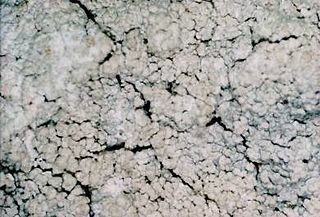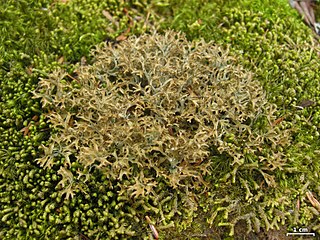
Ochrolechia is a genus of crustose lichens in the family Ochrolechiaceae. These lichens typically form uneven, often thick, crust-like growths on various surfaces and are characterised by their white to pale grey thalli, which may have a greenish tint. The genus has a long evolutionary history, with fossils dating back to the Paleogene period, about 34 million years ago. Ochrolechia species have disc-like apothecia, which are usually yellowish or brownish-pink and often covered with a fine white powdery coating. The genus is widely distributed and includes both common and rare species, with some found in extreme environments such as arctic and alpine regions. Ochrolechia lichens produce diverse secondary metabolites, including orcinol depsides, depsidones, and xanthones.

Felipes is a genus of lichenized fungi in the order Arthoniales. Circumscribed by Andreas Frisch and Göran Thor in 2014, it contains the single species Felipes leucopellaeus. Genetic analysis shows that the genus falls into the order Arthoniales, but its familial placement is uncertain. Felipes leucopellaeus is found across Europe and North America in temperate and boreal regions, typically in old-growth forest or wooded mires. It is crustose and corticolous.

Pseudephebe is a genus of fruticose lichens in the family Parmeliaceae. It contains three species that grow on rocks.
Japewiella is a genus of lichen in the family Lecanoraceae. It was circumscribed in 2000 by German botanist and lichenologist Christian Printzen as a segregate of the genus Japewia. The genus name of Japewia was in honour of Peter Wilfrid James, who was an English botanist. The genus was circumscribed by Christian Printzen in Bryologist vol.102 on page 715 in 1999.

Lepraria is a genus of leprose crustose lichens that grows on its substrate like patches of granular, caked up, mealy dust grains. Members of the genus are commonly called dust lichens. The main vegetative body (thallus) is made of patches of soredia. There are no known mechanisms for sexual reproduction, yet members of the genus continue to speciate. Some species can form marginal lobes and appear squamulose. Because of the morphological simplicity of the thallus and the absence of sexual structures, the composition of lichen products are important characters to distinguish between similar species in Lepraria.

Haematomma ochroleucum, also known as yellow bloodstain lichen, is a species of crustose lichenized fungus. First described in 1771 by Noël Martin Joseph de Necker, it has no subspecies, but two named varieties: H. o. var. ochroleucum and H. o. var. porphyrium.

Punctelia rudecta, commonly known as the rough speckled shield or the speckleback lichen, is a North American species of foliose lichen in the family Parmeliaceae. This species can be readily identified by the light color of the thallus underside, the relatively large lobes at the edges of the thallus, and the tiny white pores present on the top of the thallus that are characteristic of the genus Punctelia. The lichen is quite abundant and widespread in the eastern and southeastern United States, although it also occurs in Canada and northern Mexico, but is less common in these regions. The lichen usually grows on bark, and less commonly on shaded rocks. There are several lookalike Punctelia species; these can often be distinguished from P. rudecta by differences in distribution or in the nature of the reproductive structures present on the thallus.

Punctelia appalachensis, commonly known as the Appalachian speckled shield lichen, is a species of foliose lichen in the family Parmeliaceae. It is found in the eastern United States and eastern Canada. The lichen was first formally described in 1962 by lichenologist William Culberson as a species of Parmelia. He collected the type specimen growing on tree bark in West Virginia, Hildur Krog transferred it to the newly circumscribed genus Punctelia in 1982.

Punctelia bolliana, the eastern speckled shield lichen, is a species of foliose lichen in the family Parmeliaceae. It is found in North America, with a distribution extending from the Canadian province of Ontario south to the central and northeastern United States and Mexico. It grows on the bark of both deciduous trees and coniferous trees. The combination of characteristics that distinguishes this species from others in genus Punctelia are the absence of the vegetative propagules isidia and soralia, a pale brown lower thallus surface, and the presence of the secondary chemical protolichesterinic acid in the medulla.

Loxospora ochrophaea is a species of crustose lichen in the family Sarrameanaceae.

Vainionora americana is a species of crustose lichen in the family Lecanoraceae that is found in the United States. It was described as a species new to science in 2004 by the lichenologists Klaus Kalb, Tor Tønsberg, and John Alan Elix. The type was collected by Tønsberg from the southern Appalachian Mountains of North Carolina, where it was found growing on the bark of a maple tree. It was later recorded in Alabama.

Lepraria harrisiana is a species of leprose lichen in the family Stereocaulaceae. It is widespread in the eastern United States where it occurs in humid habitats, such as conifer swamps and riparian forests.

Ochrolechia africana, commonly known as the frosty saucer lichen, is a species of crustose and corticolous (bark-dwelling) lichen in the family Ochrolechiaceae. It is a widely distributed species, found in tropical and subtropical areas of southern Africa, Asia, Australia, North America, and South America. The lichen is characterized by the presence of a white "frosty" or powdery apothecia.

Cetraria laevigata is a species of ground-dwelling, fruticose (bushy) lichen in the family Parmeliaceae. It was formally described as a new species by Russian lichenologist Kseniya Aleksandrovna Rassadina in 1943. In North America, it is commonly known as the striped Iceland lichen.

Lecidea tessellata is a species of saxicolous (rock-dwelling), crustose lichen in the family Lecideaceae. It was formally described as a species in 1819 by German botanist Heinrich Flörke. In northern North America, it is common and widely distributed, growing on non-calcareous rocks. It also occurs in Afghanistan, China, Nepal, Europe, and Russian Asia. In India, it has been recorded only from the alpine Western Himalayas at an altitude of 3,450 m (11,320 ft). Its southern distribution extends to James Ross Island, where it is locally common.
Phlyctis monosperma is a species of corticolous (bark-dwelling), crustose lichen in the family Phlyctidaceae. It is characterised by its greyish-white, loose, granular thallus, single-spored asci, and distinctive chemical substances. The lichen is found in the subtropical evergreen forests of the Eastern Himalayas and Western Ghats of India, where it grows on rough tree bark in close association with plant-dwelling bryophytes at elevations above 2,000 m (6,600 ft). It also occurs in Sri Lanka.

Piccolia nannaria is a species of crustose lichen in the class Lecanoromycetes. It is widespread but uncommon in the coastal plain of southeastern North America. Initially thought to be corticolous (bark-dwelling), later collection of the lichen suggest that it may be lichenicolous (lichen-dwelling).

Chrysothrix chlorina, the sulphur dust lichen, is a species of leprose (powdery) crustose lichen in the family Chrysotrichaceae. Originally described scientifically by the Swedish lichenologist Erik Acharius over 200 years ago, it has been shuffled to many different genera in its taxonomic history before finally being transferred to Chrysothrix in 1981. The lichen has a circumboreal distribution, meaning it occurs in northern boreal regions across the planet. It is typically saxicolous (rock-dwelling), particularly on the underside of rock overhangs, but has in rare instances been recorded growing on bark and various other surfaces.

Pseudothelomma ocellatum is a species of lignicolous (wood-dwelling), crustose lichen in the family Caliciaceae. This lichen is characterised by its grey, areolate thallus that produces abundant lichenised diaspores, such as short spherical isidia and coarse, dark brown-black soredia. It is typically sterile, meaning apothecia are absent.

Melanelia hepatizon, commonly known as the rimmed camouflage lichen or the rimmed brown-shield, is a species of saxicolous (rock-dwelling), foliose lichen in the family Parmeliaceae. Its thallus, ranging in colour from brown to black, features narrow, elongated lobes that can be flat, convex, or concave. This lichen has a circumpolar distribution, occurring in Asia, Europe, North America, Iceland, and Greenland.

















